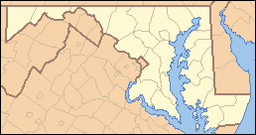Fort George G. Meade Museum
| Fort George G. Meade | |
| Military installation | |
|
Maryland Route 175 is beyond the main gate
|
|
| Eponym: George Meade, Army of the Potomac | |
| Country | |
|---|---|
| State | |
| County | |
| Part of | Intelligence and Security Command |
| Borders on |
E: Severn, Maryland, W: National Cryptologic Museum, W: National Vigilance Park, W: Training School Cemetery |
| Parts | Fort Meade CDP |
| Location | wooded lot |
| - elevation | 173 ft (53 m) |
| - coordinates | 39°6′25″N 76°44′35″W / 39.10694°N 76.74306°WCoordinates: 39°6′25″N 76°44′35″W / 39.10694°N 76.74306°W |
| Area | 7.92 sq mi (20.5 km2) |
| - CDP | 6.6 sq mi (17.1 km2) |
| Population | 48,008 CDP residents dependants: 6,000 42,133 employed (2010) military: ≈10,689 NSA: >20,000 DISA: 4000 |
| Access | Controlled |
| GNIS ID | 2512196 |
|
Fort Meade is along the Baltimore–Washington Parkway near the Baltimore/Washington airport
|
|
| Website: WWW.FTMEADE.ARMY.MIL | |
Fort George G. Meade is a United States Army installation located in Maryland, that includes the Defense Information School, the Defense Media Activity, the United States Army Field Band, and the headquarters of United States Cyber Command, the National Security Agency, the Defense Courier Service, and Defense Information Systems Agency headquarters. It is named for George G. Meade, a general from the U.S. Civil War, who served as commander of the Army of the Potomac. The fort's smaller census-designated place includes support facilities such as schools, housing, and the offices of the Military Intelligence Civilian Excepted Career Program (MICECP).
Initially called Camp Annapolis Junction, the post was opened as "Camp Admiral" in 1917 on 29.7 sq mi (77 km2) acquired for a training camp. The post was called Camp Meade Cantonment and Field Signal School by 1918, and in 1919, the Camp Benning tank school—formed from the World War I Camp Colt and Tobyhanna schools—was transferred to the fort before the Tank Corps was disbanded. Renamed to Fort Leonard Wood (February 1928 – March 5, 1929), the fort's Experimental Motorized Forces in the summer and fall of 1928 tested vehicles and tactics in expedition convoys (Camp Meade observers had joined the in-progress 1919 Motor Transport Corps convoy). In 1929, the fort's 1st Tank Regiment encamped on the Gettysburg Battlefield. During World War II, Fort Meade was used as a recruit training post and prisoner of war camp, in addition to a holding center for approximately 384 Japanese, German and Italian immigrant residents of the U.S. arrested as potential fifth columnists. The Second U.S. Army Headquarters transferred to the post on June 15, 1947; and in the 1950s, the post became headquarters of the National Security Agency.
...
Wikipedia


